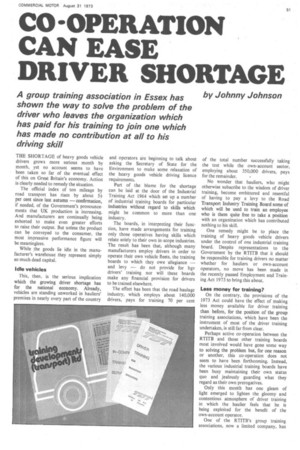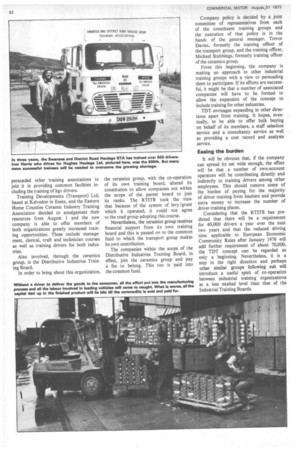CO-OPERATION CAN EASE DRIVER SHORTAGE
Page 47

Page 48

If you've noticed an error in this article please click here to report it so we can fix it.
by Johnny Johnson A group training association in Essex has shown the way to solve the problem of the driver who leaves the organization which has paid for his training to join one which has made no contribution at all to his driving skill
THE SHORTAGE of heavy goods vehicle drivers grows more serious month by month, yet no account seems to have been taken so far of the eventual effect of this on Great Britain's economy. Action is clearly needed to remedy the situation.
The official index of ton mileage by road transport has risen by about per cent since last autumn confirmation, if needed, of the Government's pronouncements that UK production is increasing. And manufacturers are continually being exhorted to make even greater efforts to raise their output. But unless the product can be conveyed to the consumer, the most impressive performance figure will be meaningless.
While the goods lie idle in the manufacturer's warehouse they represent simply so much dead capital.
Idle vehicles This, then, is the serious implication which the growing driver shortage has for the national economy. Already, vehicles are standing unworked in hauliers' premises in nearly every part of the country and operators are beginning to talk about asking the Secretary of State for the Environment to make some relaxation of the heavy goods vehicle driving licence requirements.
Part of the blame for the shortage can be laid at the door of the Industrial Training Act 1964 which set up a number of industrial training boards for particular industries without regard to skills which might be common to more than one industry.
The boards, in interpreting their function, have made arrangements for training only those operatives having skills which relate solely to their own in-scope industries. The result has been that, although many manufacturers employ drivers in order to operate their own vehicle fleets, the training boards to which they owe allegiance — and levy — do not provide for hgv drivers' training nor will these boards make any financial provision for drivers to be trained elsewhere.
The effect has been that the road haulage industry, which employs about 140,000 drivers, pays for training 70 per cent of the total number successfully taking the test while the own-account sector, employing about 350,000 drivers, pays for the remainder.
No wonder that hauliers, who might otherwise subscribe to the wisdom of driver training, become embittered and resentful of having to pay a levy to the Road Transport Industry Training Board some of which will be used to train an employee who is them quite free to take a position with an organization which has contributed nothing to his skill.
One remedy might be to place the training of heavy goods vehicle drivers under the control of one industrial training board. Despite representations to the Government by the RTITB that it should be responsible for training drivers no matter whether for hauliers or own-account operators, no move has been made in the recently passed Employment and Training Act 1973 to bring this about.
Less money for training?
On the contrary, the provisions of the 1973 Act could have the effect of making less money available for driver training than before, for the position of the group training associations, which have been the instrument of most of the driver training undertaken, is still far from clear.
Perhaps active co-operation between the RTITB and those other training boards most involved would have gone some way to solving the problem but, for one reason or another, this co-operation does not seem to have been forthcoming. Instead, the various industrial training boards have been busy maintaining their own status quo and jealously guarding what they regard as their own prerogatives.
Only this month has one gleam of light emerged to lighten the gloomy and contentious atmosphere of driver training in which the haulier feels that he is being exploited for the benefit of the own-account operator.
One of the RTITB's group training associations, now a limited company, has persuaded other training associations to join it in providing common facilities inchiding the training of hgv drivers.
Training Developments (Transport) Ltd, based at Kelvedon in Essex, and the Eastern Home Counties Ceramic Industry Training Association decided to amalgamate their resources from August 1 and the new company is able to offer members of both organizations greatly increased training opportunities. These include management, clerical, craft and technician courses as well as training drivers for both industries.
Also involved, through the ceramics group, is the Distributive Industries Training Board.
In order to bring about this organization, the ceramics group, with the co-operation of its own training board, altered its constitution to allow companies not within the scope of the parent board to join its ranks. The RTITB took the view that because of the system of levy /grant which it operated, it could not agree to the road group adopting this course.
Nevertheless, the ceramics group receives financial support from its own training board and this is passed on to the common fund to which the transport group makes its own contribution.
The companies within the scope of the Distributive Industries Training Board, in effect, join the ceramics group and pay a fee to belong. This too is paid into the common fund. Company policy is decided by a joint committee of representatives from each of the constituent training groups and the execution of that policy is in the hands of the general manager, Trevor Davies, formerly the training officer of the transport group, and the training officer, Michael Stubbings, formerly training officer of the ceramics group.
From this beginning, the company is making an approach to other industrial training groups with a view to persuading them to participate. If its efforts are successful, it might be that a number of associated companies will have to be formed to allow the expansion of the concept to include training for other industries.
TDT envisages expanding in other directions apart from training. It hopes, eventually, to be able to offer bulk buying on behalf of its members, a staff selection service and a consultancy service as well as providing a cost record and analysis service.
Easing the burden It will be obvious that, if the company can spread its net wide enough, the effect will be that a number of own-account operators will be contributing directly and indirectly to training drivers among other employees. This should remove some of the burden of paying for the majority of driver training from hauliers and provide extra money to increase the number of driver-training places.
Considering that the RTITB has predicted that there will be a requirement for 40,000 drivers a year over the next two years and that the reduced driving time applicable to European Economic Community Rules after January 1976 will add further requirement of about 70,000, the TDT concept can be regarded as only a beginning. Nevertheless, it is a step in the right direction and perhaps other similar groups following suit will introduce a useful spirit of co-operation between industrial training organizations at a less exalted level than that of the Industrial Training Boards.












































































































